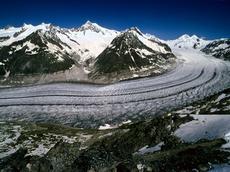New calculation for the ice volume of the Swiss glaciers
Scientists at ETH Zurich have developed a new method of calculating ice volume and used it to recalculate the size of the Swiss glaciers. In 1999, the total ice volume of approximately 1500 glaciers in Switzerland was estimated at 74 cubic kilometres. Since then, however, some 12 percent has already melted away.

The earth’s glaciers are one of the “uncertain” factors in climate forecasts. It is difficult to precisely calculate the ice volume, making its effects – such as a rising sea level – unpredictable. However, melting glaciers do not only contribute to a rising sea level. They cause a reduction in freshwater supplies and change the landscape and ecosystems forever. Switzerland is also affected: Swiss glaciers have reduced dramatically in size over the past twenty years, particularly during the past ten years, which has been the warmest decade of the past 150 years.
A new method of calculation can now more accurately determine just how much ice the Swiss glaciers have lost. The process was developed by Martin Funk, professor and head of the Department for Glaciology at the Laboratory for Hydraulics, Hydrology and Glaciology (Versuchsanstalt für Wasserbau, Hydrologie und Glaziologie - VAW) and his team at ETH Zurich, in order to estimate the total ice volume of the Swiss glaciers. Knowing the exact volume is important to be able to put the observed change in the right context. Previously, however, the volume of only very few glaciers was known reliably. For these glaciers, it was possible to determine the ice thickness and the approximate volume through drillings or echo-sounding examinations. The researchers were able to calibrate their new process on these glaciers.
Estimation based on mass conservation
Up until now, glacier volumes were calculated based on empirical relationships between glacier area and volume, according to Daniel Farinotti, postgraduate student studying under Funk. The scientists developed their method of calculation based on the law of mass conservation for glaciers. This states that the surface mass budget must be balanced by the flow of ice and the changes in the thickness of the glacier’s ice. The ice volume is ultimately calculated using the glacier’s topography and the estimated area spread of the surface mass budget. The ice flow is first determined using the basic laws of glacial mechanics, including the geometry of the glacier surface, which in turn is used to calculate the thickness of the ice. Unlike previous estimation methods, the newly developed method does not just give indications on the ice volume of the glacier, but also the spread of the ice’s thickness. This also allows the topography of the glacial bed to be determined.
Large glaciers are decisive
The scientists have now applied their method to 59 Swiss glaciers, which were larger than three square kilometres in 1999, and three smaller glaciers for which thickness measurements were already available. For the approximately 1400 remaining glaciers, the scientists deduced the ice volume using an empirical volume-area approach. Their calculations showed that the ice volume amounted to 74 cubic kilometres in 1999, with a possible deviance of 9 cubic kilometres. All of the Swiss glacial ice masses would therefore easily fit into Lake Geneva – which has a water volume of 89 cubic kilometres.
The researchers further calculated an average ice thickness of seventy metres. They were also able to show that 88 percent of the ice mass is contained in the 59 largest glaciers, of which 24 percent are in the Aletsch region alone. “The area of the Great Aletsch Glacier is roughly the same as the total area of all Swiss glaciers less than one square kilometre in size. Their total ice volume, however, is twenty times smaller than the Great Aletsch Glacier. Scientists maintain that in order to provide a more accurate estimation of the regional ice volume, it is vital to carry out further thickness measurements on the largest glaciers in Switzerland, as these are obviously particularly consequential when calculating the volume.
Scientists calculated the development of the size of the glaciers over the past ten years by using an average mass timeline. “The timeline took an average from around 30 glaciers where we have data on changes in volume”, states Farinotti. This showed that the heat wave in 2003 was responsible for 2.6 of the total of 9 cubic kilometres of ice lost.
Glaciers have been shrinking since 1850
The development of the Swiss glaciers has been observed and documented since 1880. The current calculations are based on data recorded in 1999 at the time when the survey of Swiss glaciers was last updated with satellite images combined with a geographic information system and a digital contour model. The last time this was done was in 1973. Based on these data, calculations on the volume of Swiss glacial ice were between 74 and 67 cubic kilometres. “Although these figures are similar to ours, they are based on much less accurate data. The fact that a considerable amount of ice has melted since then suggests that the ice volume for 1973 was somewhat underestimated”, states Farinotti.
Since the last minor ice age,
which ended around 1850, the area covered by glaciers has been shrinking. In
1999, around 1063 square kilometres remained.
References:
Farinotti D, Huss M, Bauder A, Funk M & Truffer M.: A method to
estimate ice volume and ice thickness distribution of alpine glaciers. Journal of Glaciology (2009), 55,
422-430.
Farinotti D, Huss M, Bauder A & Funk M: An
estimate of the glacier ice volume in the Swiss Alps. Global and Planetary
Change (2009).







READER COMMENTS